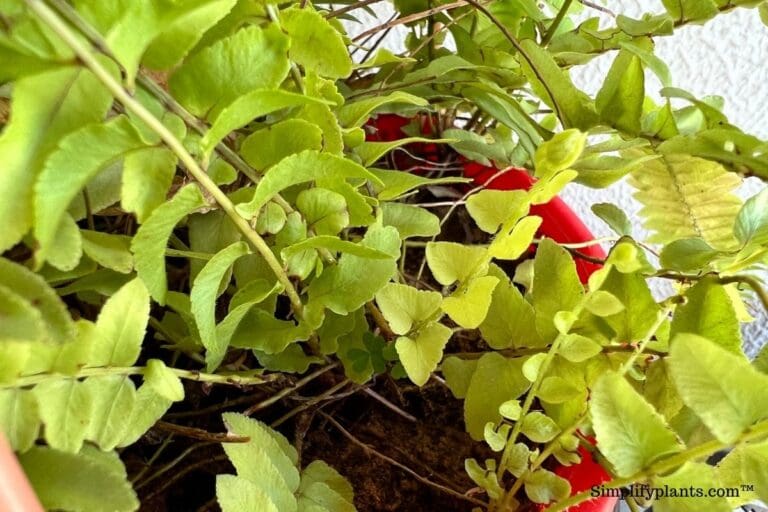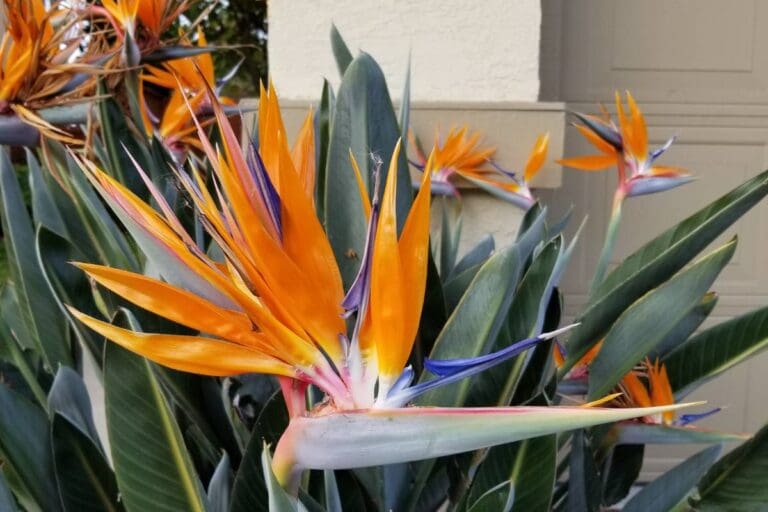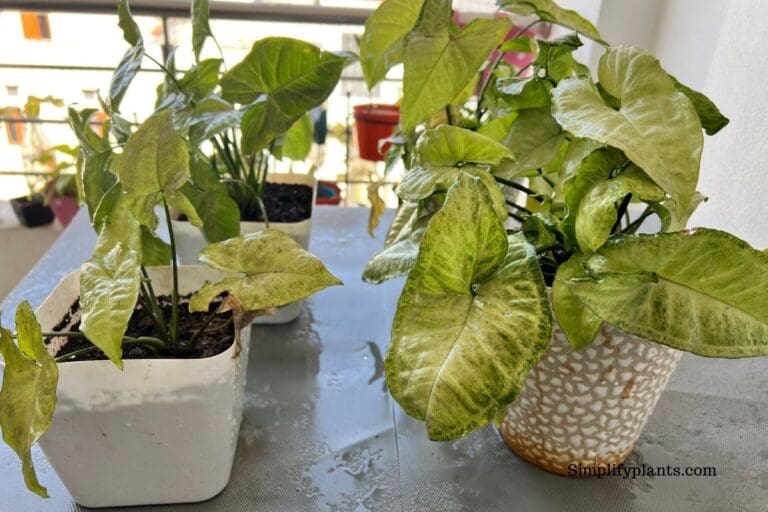What Kind Of Light Does A Schefflera Need?
Schefflera plants, also known as umbrella plants, are low-maintenance houseplants loved by many due to their hardy and easy-to-care lifespan.
Clusters of shiny broad leaves that cascade from the branches of this plant fills up a lot of space, instantly adding life to dull corners.
The Schefflera plant generally requires medium bright light, though occasionally they can tolerate bright light but not direct sunlight. Direct sunlight can burn the leaves and discolor them, and poor lighting will affect your umbrella plant growth, making it leggy and droopy.
You must understand the light requirement correctly so that the plant grows in good health.
In this article, I will discuss the light requirements of the Umbrella plant and understand what measures need to be taken to give the required light to this plant.
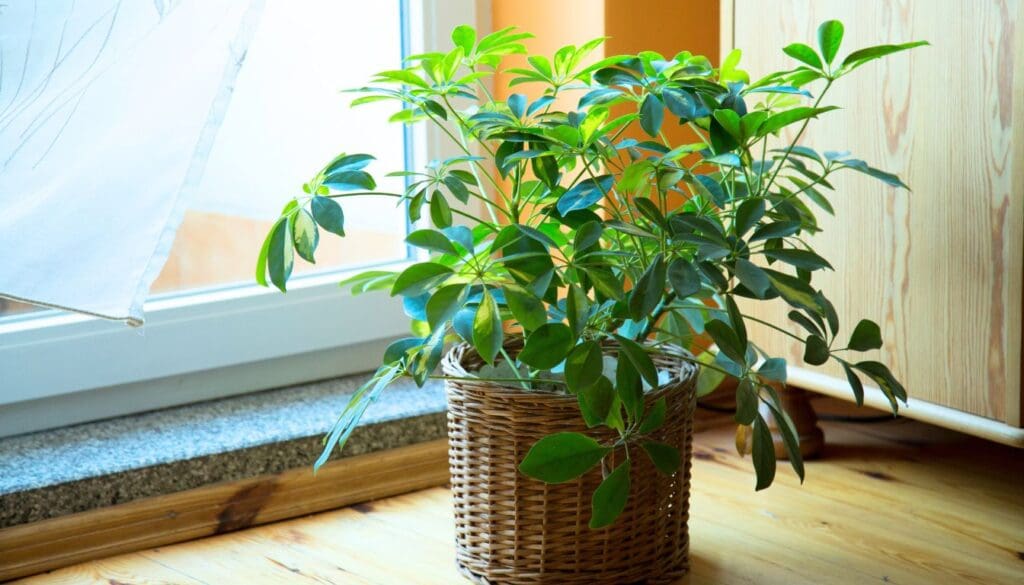
Please note: Simplify Plants is reader-supported. Some links in the post are affiliate links and I get a commission from purchases made through links in the post.
Importance of good lighting
Light is among the essential elements required for plants to carry on with photosynthesis.
This process helps convert the light, water, and oxygen into carbohydrates, which is how the plant gets its energy, the food for the plant.
This energy lets the plant live, grow, bloom, and produce seeds and fruits.
Without adequate light, carbohydrates or this energy cannot be produced, making the plant weak and leading to death eventually.
In the absence of sufficient light, the plant cannot make its food which shows its effect on the plant’s health.
Therefore, it is of primary importance that the Schefflera plant gets adequate light for its essential development.
What kind of light is needed for Schefflera?
Schefflera plants grow in tropical regions of Taiwan, Australia, and New Guinea.
In their native land, they grow outdoors, where they get enough required light in nature.
However, it is tricky to get the right amount of light that will suit the plant best when choosing to grow them indoors.
These plants do not require direct sunlight but need bright indirect light in indoor settings for ideal growth.
In nature, these plants grow in humid and warm regions where they grow in the shade and dappled sunlight.
So it is important to give that setting to the plant while growing them indoors.
Let us discuss the amount of light your Umbrella plant needs and where to place them.
Direct vs. indirect light
While talking about light requirements for your plants, we often come across the terms direct light and indirect lights.
Let us quickly understand the meaning of these terms.
Direct sunlight means the sun’s direct rays that fall on the plants.
This is intense, and the afternoon direct sunlight can be scorching.
Certain plants like fruits and flowering plants, outdoor plants, and cacti need this kind of direct sunlight to produce the maximum energy.
Indirect light is the type of light that is mostly required for houseplants.
These are less intense and hot, and the direct sunlight does not fall on the plant, but the plant uses heat and light to make its food.
Exposure to sun

Houseplants like Schefflera grows best in an indirect light setting which is not too intense but is just sufficient for the plant to grow efficiently.
Exposure to direct sunlight that is too hot can damage this plant, burn the leaves, and dehydrate them.
However, you must understand keeping it away from direct sunlight does not mean it can thrive in low light.
The plant needs plenty of bright but indirect light to flourish.
Understanding this balance is crucial.
The direction of the sun
Having some basic knowledge about the direction and the position of the sun helps in choosing the right spot for your Schefflera, which can give it the right light.
An east-facing window is ideal for the Umbrella plant’s healthy growth because this spot receives the morning sunlight, which is mild and less intense than the afternoon sunlight.
On the other hand, the west-facing window sometimes receives stronger intense sunlight in the afternoon, which is not always suitable for your Schefflera.
Your plant might face sunburn and dehydration in summer with the scorching sunlight.
If you keep your Umbrella plant on the west side, you can hang a curtain to protect the plant from direct sunlight or keep the plant 5 to 7 feet away from the window.
A north-facing window, in most cases, is quite dim and low light, which is not suitable for your plant.
A south-facing window might not get the direct sunlight but enjoys plenty of bright light and air circulation that suits most plants like Schefflera.
Summer vs. winter lighting needs
The intensity of sunlight always changes with seasons, so it is also important to understand the role of seasons in the amount of sunlight along with the sun’s direction.
During summer, the intensity of the sun’s rays is at its peak.
Thereby the plant stands more chances of getting dehydrated and burnt.
You must protect your Schefflera from the intense sunlight by putting a curtain or keeping plants away from windows to keep them cool.
Unlike some other plants, Schefflera does not get completely dormant in winters.
The sunlight is milder, and it significantly reduces the chances of sunburn.
You can expose your Schefflera to a few hours of morning sunlight in winters, which you cannot do in summer.
This provides the plant with some amount of warmth which is good for the plant.
The lack of warmth and intense light is one of the reasons for plants going dormant during winters, so it is recommended to give some sunlight during winters.
Best spot for Schefflera

Schefflera plant is known to survive in full shade, unlike certain plants like crotons which need very bright light.
However, if you continue keeping this plant in low light for a long time, it will affect the plant’s health.
So it is recommended to choose a spot with lots of bright light but not direct sunlight.
This will give the plant all its warmth without burning the leaves.
This will also prevent the plant from becoming leggy and feeble-looking and push out more healthy growth.
If you have a south-facing window, you can keep your plant there or keep it in an east-facing window in winters.
If you have a shaded balcony, your Schefflera will thrive well there.
However, if your house does not get ample bright light, please invest in artificial lights to give your essential warmth and light for photosynthesis.
Impact of too much light on Schefflera
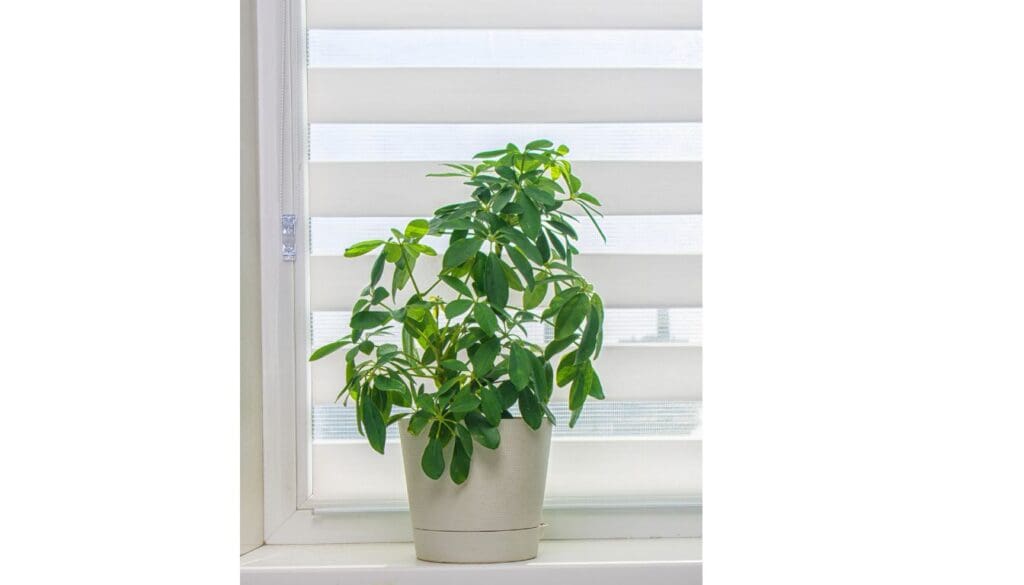
Like most tropical plants, Scheffeleras that grow indoors cannot tolerate direct sunlight.
By placing your plant in a spot where it receives extreme direct rays of sunlight, you risk harming the plant.
Several signs show that your plants will show if it gets too much sunlight.
- Sunburn: Scheffleras grown in containers are prone to getting sunburned. When they are kept on windows and the glass heats, contact with this windowpane can burn your plant’s leaves. These leaves start turning yellow and then brown and eventually fall off. It is best to cut off these leaves as the browning is irreversible.
- Dehydrated and crispy leaves: Exposure to too much direct light combined with dehydration can turn the leaves dry and crispy. The solution is to move the plant to a shadier area and water it thoroughly until it runs off the drain hole.
- Dry soil: Too intense sunlight will increase the evaporation process. This will dry up the soil frequently, making the plant dehydrated.
What to do if my Schefflera gets too much light?
Do not panic when you see the signs mentioned above on your plants.
Do not panic and follow the step below.
- Firstly if you notice the signs that your Schefflera is getting too much light, you need to change its location.
- Shift the plant to a spot where it does not get direct sun rays but will enjoy bright to medium indirect light.
- Trim off all the yellow, brown, and pale leaves with a clean pruner. These leaves will not go back to their original color, so it is best to cut them off.
- Take the plant out of its pot and dip it in a bucket of water to let the soil soak in all the moisture it needs.
- Do not fertilize the plant until it recovers because that can cause further stress to the plant.
- Water when you see the top 2-3 inches of soil drying.
Impact of low light on your Schefflera

Schefflera can tolerate shade but not extremely low light.
Exposure to low light conditions for a long time can affect the healthy growth of the Schefflera plant.
These plants tend to get leggy and malnourished if they do not get sufficient light which hampers their growth.
Certain plants like ZZ and snake plants can tolerate low light conditions; however, Schefflera cannot at all tolerate low light.
Their growth slows, and their new leaves’ size reduces under lowlight conditions.
Low light also increases overwatering, root rot, and pest infestations.
Some of the signs of insufficient lights are:
- Leggy plant: The stem of your Schefflera starts growing long and thin in search of light. However, it does not grow in width. The leaves get smaller and weaker, and the gap between the leaves widens due to less available light.
- Smaller leaves: As the sunlight availability decreases, the size of your plant’s leaves also decreases. This happens because low light gives the plant lower energy. So to preserve more energy, the plant fails to grow to its full potential.
- Leaning plant: The plant starts to grow tall in search of light in the direction of the light. This makes the plant grow crooked. To prevent this, you should rotate your plant weekly so that all sides get even light.
- Stunted growth: Low light reduces the capacity for photosynthesis of the plant. Hence the growth rate of the plant also decreases.
What to do if my Schefflera is not getting enough sunlight?

If you see your plant is not getting enough light and it is showing the above signs, there are certain steps you should follow.
- Move your plant to a spot that gets indirect bright to medium light.
- If your house does not get much natural light, use artificial lights like fluorescent and LED lights. You need to keep the plants under these lights. They are especially useful in the winter months.
- Reduce the watering frequency to reduce the chances of overwatering and root rot. Water only when you see the topsoil getting dry. Low light reduces the plant’s evaporation rate, which keeps the soil wet for a longer time, giving rise to chances of overwatering and fungus growth.
- Keep the leaves of your Schefflera clean to help it conduct maximum photosynthesis.
- Rotate the plant every week to provide light to all the sides of the plant to get adequate and even light to prevent the plant from getting leggy.
Final thoughts

Correct lighting is a vital necessity for any plant to make its food and grow. Schefflera or Umbrella plants are easy to grow, hardy plants that can tolerate bright to medium indirect sunlight.
However, if you keep neglecting this plant and keep it in an unfavorable lighting situation for a long time, it is bound to hamper the plant’s health, making it leggy and skinny.
At the same time, too much light can burn the leaves and make them yellow.
Understanding the right balance between too much and too little light is the key to choosing the best spot for your plant.
For a healthy, thriving Umbrella plant, sufficient light is very important to produce sufficient food and flourish well.
After reading this article, I hope all your queries about your Schefflera plant’s correct lighting conditions have been answered.
Reference: Wikipedia, Sciencedirect, Britannica, American Society for Horticultural Science, Schefflera taxonomic history.
Recommended Garden Supplies
| Product Image | Our Recommended Gardening Supplies | Check Offers! |
|---|---|---|
Top Top
Top
Top
Top
Top
Top
Top
Top | rePotme Houseplant and Tropical Classic Potting Soil Mix | Check Offer On Amazon |
 Top
Top
Top
Top
Top
Top
Top
Top | Espoma Organic Indoor Plant Food | Check Offer On Amazon |
 Top
Top
Top
Top
Top
Top
Top
Top | GooingTop LED Grow Light 6000K Full Spectrum Clip Plant Growing Lamp | Check Offer On Amazon |
 Top
Top
Top
Top
Top
Top
Top
Top | Soil Moisture Meter | Check Offer On Amazon |
 Top
Top
Top
Top
Top
Top
Top
Top | Govee Hygrometer Thermometer, Bluetooth Enabled! | Check Offer On Amazon |
 Top
Top | LEVOIT Humidifiers for Large Room(Best For Plants) | Check Offer On Amazon |
 Top
Top
Top
Top
Top
Top
Top
Top | Upgraded DIY Automatic Drip Irrigation Kit, 15 Potted Houseplants Support | Check Offer On Amazon |
 Top
Top
Top
Top
Top
Top
Top
Top | Stainless Steel Heavy Duty Gardening Tool Set | Check Offer On Amazon |
 Top
Top
Top
Top
Top
Top
Top
Top | Bonide Insecticidal Soap | Check Offer On Amazon |
 Top
Top
Top
Top
Top
Top
Top
Top | Bonide 32 oz Spray Neem Oil for Organic Gardening | Check Offer On Amazon |
 Top
Top
Top
Top
Top
Top
Top
Top | Garden Safe Fungicide | Check Offer On Amazon |


